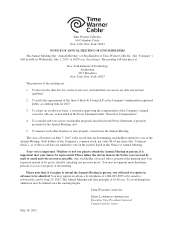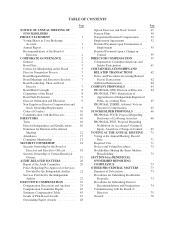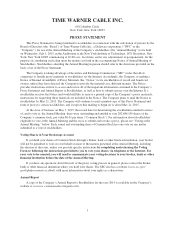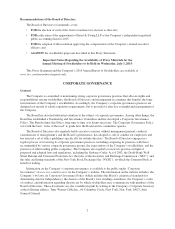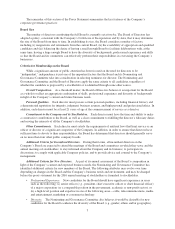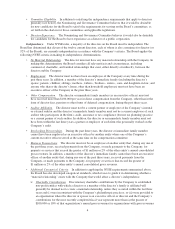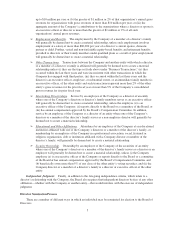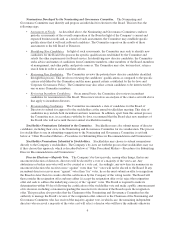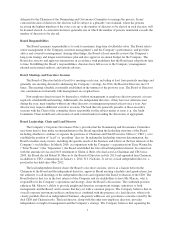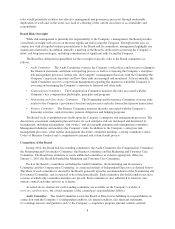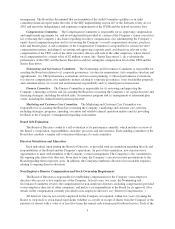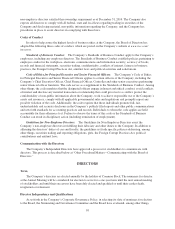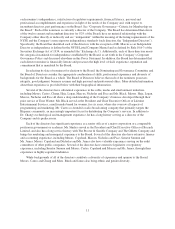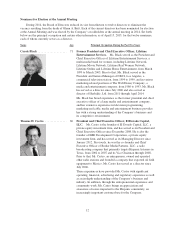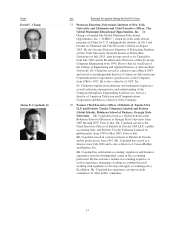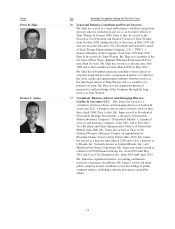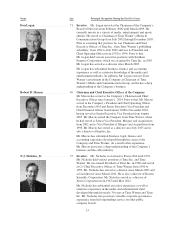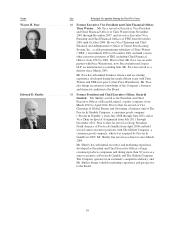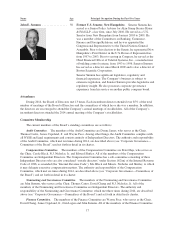Time Warner Cable 2015 Annual Report Download - page 13
Download and view the complete annual report
Please find page 13 of the 2015 Time Warner Cable annual report below. You can navigate through the pages in the report by either clicking on the pages listed below, or by using the keyword search tool below to find specific information within the annual report.delegated to the Chairman of the Nominating and Governance Committee to manage the process. In any
contested election of directors, the election will be subject to a plurality vote standard, where the persons
receiving the highest numbers of the votes cast, up to the number of directors to be elected in such election, will
be deemed elected. A contested election is generally one in which the number of persons nominated exceeds the
number of directors to be elected.
Board Responsibilities
The Board’s primary responsibility is to seek to maximize long-term stockholder value. The Board selects
senior management of the Company, monitors management’s and the Company’s performance, and provides
advice and counsel to management. Among other things, the Board at least annually reviews the Company’s
long-term strategy and longer-term business plan and also approves an annual budget for the Company. The
Board also reviews and approves transactions in accordance with guidelines that the Board may adopt from time
to time. In fulfilling the Board’s responsibilities, directors have full access to the Company’s management,
internal and external auditors, and outside advisors.
Board Meetings and Executive Sessions
The Board of Directors holds at least five meetings each year, including at least four quarterly meetings and
generally one meeting devoted to addressing the Company’s strategy. In 2014, the Board of Directors met 13
times. The meeting schedule is normally established in the summer of the previous year. The Board of Directors
also communicates informally with management on a regular basis.
Non-employee directors meet by themselves, without management or employee directors present, at every
regularly scheduled Board meeting. Additionally, the independent directors, if they have not otherwise met
during the year, meet together without any other directors or management present at least once a year. Any
director may request additional executive sessions. The lead director generally presides at these executive
sessions with the Chair of the committee that is responsible for the subject matter at issue (e.g., the Audit
Committee Chair would lead a discussion of audit-related matters) leading the discussion, if appropriate.
Board Leadership: Chair and Lead Director
The Company’s Corporate Governance Policy provides that the Nominating and Governance Committee
may from time to time make recommendations to the Board regarding the leadership structure of the Board,
including whether to combine or separate the positions of Chairman and Chief Executive Officer (“CEO”), or to
establish the position of “lead” or “presiding” director. In making the leadership structure determination, the
Board considers many factors, including the specific needs of the business and what is in the best interests of the
Company’s stockholders. In March 2009, in conjunction with the Company’s separation from Time Warner Inc.
(“Time Warner”) (the “Separation”), the Board established the role of lead independent director. In connection
with the announced year-end 2013 retirement of Glenn A. Britt, who had acted as Chairman and CEO since
2009, the Board elected Robert D. Marcus to the Board of Directors in July 2013 and appointed him Chairman,
in addition to CEO, commencing on January 1, 2014. N.J. Nicholas, Jr. serves as lead independent director, a
position he has held since May 2012.
The lead independent director chairs the Board’s executive sessions, serves as a liaison between the
Chairman of the Board and the independent directors, approves Board meeting schedules and agenda items, has
the authority to call meetings of the independent directors and organizes the Board evaluation of the CEO. The
Board believes that it is in the best interest of the Company and its stockholders to have Mr. Marcus, who is
responsible for the Company’s operations and strategy, chair the Board’s discussions. The combined position
enhances Mr. Marcus’s ability to provide insight and direction on important strategic initiatives to both
management and the Board, and to ensure that they act with a common purpose. The Company believes that its
overall corporate governance policies and practices combined with the presence of a lead director, whose role
closely parallels that of an independent Chairman, adequately addresses any governance concerns raised by the
dual CEO and Chairman role. The lead director, along with the other non-employee directors, provides
independent oversight of management and the Company’s strategy. The Company believes that separating the
7


